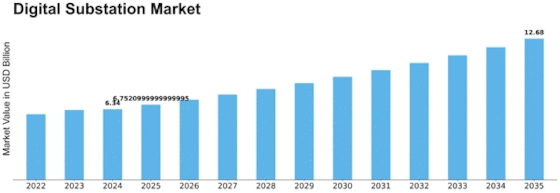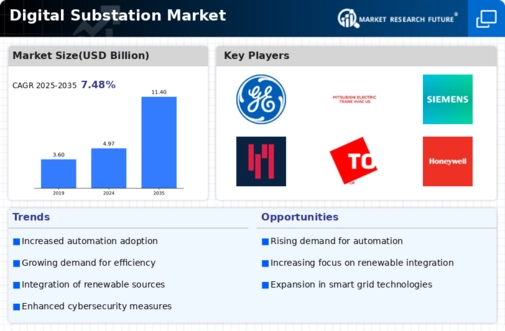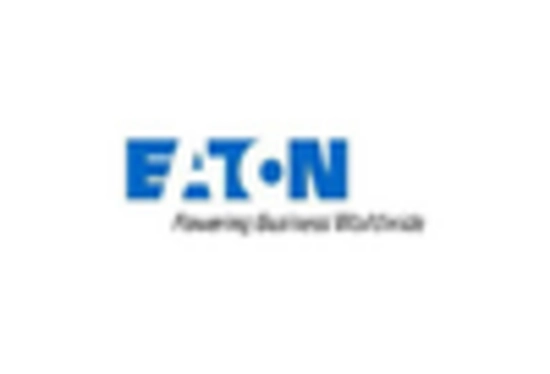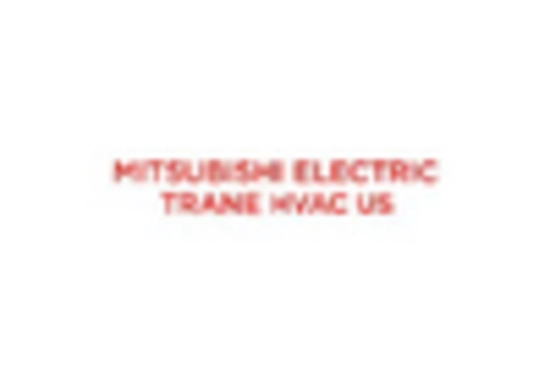Smart Grid Technology
IoT Based Technology
Automation Technology
Artificial Intelligence Technology
Control Systems
Transducers
Transformers
Switchgears
Utilities
Industrial
Commercial
Renewable Energy
High Voltage
Medium Voltage
Low Voltage
North America
Europe
South America
Asia Pacific
Middle East and Africa
North America Outlook (USD Billion, 2019-2032)
North America Digital Substation Market by Technology Type
Smart Grid Technology
IoT Based Technology
Automation Technology
Artificial Intelligence Technology
North America Digital Substation Market by Components Type
Control Systems
Transducers
Transformers
Switchgears
North America Digital Substation Market by End Use Type
Utilities
Industrial
Commercial
Renewable Energy
North America Digital Substation Market by Voltage Level Type
High Voltage
Medium Voltage
Low Voltage
North America Digital Substation Market by Regional Type
US
Canada
US Outlook (USD Billion, 2019-2032)
US Digital Substation Market by Technology Type
Smart Grid Technology
IoT Based Technology
Automation Technology
Artificial Intelligence Technology
US Digital Substation Market by Components Type
Control Systems
Transducers
Transformers
Switchgears
US Digital Substation Market by End Use Type
Utilities
Industrial
Commercial
Renewable Energy
US Digital Substation Market by Voltage Level Type
High Voltage
Medium Voltage
Low Voltage
CANADA Outlook (USD Billion, 2019-2032)
CANADA Digital Substation Market by Technology Type
Smart Grid Technology
IoT Based Technology
Automation Technology
Artificial Intelligence Technology
CANADA Digital Substation Market by Components Type
Control Systems
Transducers
Transformers
Switchgears
CANADA Digital Substation Market by End Use Type
Utilities
Industrial
Commercial
Renewable Energy
CANADA Digital Substation Market by Voltage Level Type
High Voltage
Medium Voltage
Low Voltage
Europe Outlook (USD Billion, 2019-2032)
Europe Digital Substation Market by Technology Type
Smart Grid Technology
IoT Based Technology
Automation Technology
Artificial Intelligence Technology
Europe Digital Substation Market by Components Type
Control Systems
Transducers
Transformers
Switchgears
Europe Digital Substation Market by End Use Type
Utilities
Industrial
Commercial
Renewable Energy
Europe Digital Substation Market by Voltage Level Type
High Voltage
Medium Voltage
Low Voltage
Europe Digital Substation Market by Regional Type
Germany
UK
France
Russia
Italy
Spain
Rest of Europe
GERMANY Outlook (USD Billion, 2019-2032)
GERMANY Digital Substation Market by Technology Type
Smart Grid Technology
IoT Based Technology
Automation Technology
Artificial Intelligence Technology
GERMANY Digital Substation Market by Components Type
Control Systems
Transducers
Transformers
Switchgears
GERMANY Digital Substation Market by End Use Type
Utilities
Industrial
Commercial
Renewable Energy
GERMANY Digital Substation Market by Voltage Level Type
High Voltage
Medium Voltage
Low Voltage
UK Outlook (USD Billion, 2019-2032)
UK Digital Substation Market by Technology Type
Smart Grid Technology
IoT Based Technology
Automation Technology
Artificial Intelligence Technology
UK Digital Substation Market by Components Type
Control Systems
Transducers
Transformers
Switchgears
UK Digital Substation Market by End Use Type
Utilities
Industrial
Commercial
Renewable Energy
UK Digital Substation Market by Voltage Level Type
High Voltage
Medium Voltage
Low Voltage
FRANCE Outlook (USD Billion, 2019-2032)
FRANCE Digital Substation Market by Technology Type
Smart Grid Technology
IoT Based Technology
Automation Technology
Artificial Intelligence Technology
FRANCE Digital Substation Market by Components Type
Control Systems
Transducers
Transformers
Switchgears
FRANCE Digital Substation Market by End Use Type
Utilities
Industrial
Commercial
Renewable Energy
FRANCE Digital Substation Market by Voltage Level Type
High Voltage
Medium Voltage
Low Voltage
RUSSIA Outlook (USD Billion, 2019-2032)
RUSSIA Digital Substation Market by Technology Type
Smart Grid Technology
IoT Based Technology
Automation Technology
Artificial Intelligence Technology
RUSSIA Digital Substation Market by Components Type
Control Systems
Transducers
Transformers
Switchgears
RUSSIA Digital Substation Market by End Use Type
Utilities
Industrial
Commercial
Renewable Energy
RUSSIA Digital Substation Market by Voltage Level Type
High Voltage
Medium Voltage
Low Voltage
ITALY Outlook (USD Billion, 2019-2032)
ITALY Digital Substation Market by Technology Type
Smart Grid Technology
IoT Based Technology
Automation Technology
Artificial Intelligence Technology
ITALY Digital Substation Market by Components Type
Control Systems
Transducers
Transformers
Switchgears
ITALY Digital Substation Market by End Use Type
Utilities
Industrial
Commercial
Renewable Energy
ITALY Digital Substation Market by Voltage Level Type
High Voltage
Medium Voltage
Low Voltage
SPAIN Outlook (USD Billion, 2019-2032)
SPAIN Digital Substation Market by Technology Type
Smart Grid Technology
IoT Based Technology
Automation Technology
Artificial Intelligence Technology
SPAIN Digital Substation Market by Components Type
Control Systems
Transducers
Transformers
Switchgears
SPAIN Digital Substation Market by End Use Type
Utilities
Industrial
Commercial
Renewable Energy
SPAIN Digital Substation Market by Voltage Level Type
High Voltage
Medium Voltage
Low Voltage
REST OF EUROPE Outlook (USD Billion, 2019-2032)
REST OF EUROPE Digital Substation Market by Technology Type
Smart Grid Technology
IoT Based Technology
Automation Technology
Artificial Intelligence Technology
REST OF EUROPE Digital Substation Market by Components Type
Control Systems
Transducers
Transformers
Switchgears
REST OF EUROPE Digital Substation Market by End Use Type
Utilities
Industrial
Commercial
Renewable Energy
REST OF EUROPE Digital Substation Market by Voltage Level Type
High Voltage
Medium Voltage
Low Voltage
APAC Outlook (USD Billion, 2019-2032)
APAC Digital Substation Market by Technology Type
Smart Grid Technology
IoT Based Technology
Automation Technology
Artificial Intelligence Technology
APAC Digital Substation Market by Components Type
Control Systems
Transducers
Transformers
Switchgears
APAC Digital Substation Market by End Use Type
Utilities
Industrial
Commercial
Renewable Energy
APAC Digital Substation Market by Voltage Level Type
High Voltage
Medium Voltage
Low Voltage
APAC Digital Substation Market by Regional Type
China
India
Japan
South Korea
Malaysia
Thailand
Indonesia
Rest of APAC
CHINA Outlook (USD Billion, 2019-2032)
CHINA Digital Substation Market by Technology Type
Smart Grid Technology
IoT Based Technology
Automation Technology
Artificial Intelligence Technology
CHINA Digital Substation Market by Components Type
Control Systems
Transducers
Transformers
Switchgears
CHINA Digital Substation Market by End Use Type
Utilities
Industrial
Commercial
Renewable Energy
CHINA Digital Substation Market by Voltage Level Type
High Voltage
Medium Voltage
Low Voltage
INDIA Outlook (USD Billion, 2019-2032)
INDIA Digital Substation Market by Technology Type
Smart Grid Technology
IoT Based Technology
Automation Technology
Artificial Intelligence Technology
INDIA Digital Substation Market by Components Type
Control Systems
Transducers
Transformers
Switchgears
INDIA Digital Substation Market by End Use Type
Utilities
Industrial
Commercial
Renewable Energy
INDIA Digital Substation Market by Voltage Level Type
High Voltage
Medium Voltage
Low Voltage
JAPAN Outlook (USD Billion, 2019-2032)
JAPAN Digital Substation Market by Technology Type
Smart Grid Technology
IoT Based Technology
Automation Technology
Artificial Intelligence Technology
JAPAN Digital Substation Market by Components Type
Control Systems
Transducers
Transformers
Switchgears
JAPAN Digital Substation Market by End Use Type
Utilities
Industrial
Commercial
Renewable Energy
JAPAN Digital Substation Market by Voltage Level Type
High Voltage
Medium Voltage
Low Voltage
SOUTH KOREA Outlook (USD Billion, 2019-2032)
SOUTH KOREA Digital Substation Market by Technology Type
Smart Grid Technology
IoT Based Technology
Automation Technology
Artificial Intelligence Technology
SOUTH KOREA Digital Substation Market by Components Type
Control Systems
Transducers
Transformers
Switchgears
SOUTH KOREA Digital Substation Market by End Use Type
Utilities
Industrial
Commercial
Renewable Energy
SOUTH KOREA Digital Substation Market by Voltage Level Type
High Voltage
Medium Voltage
Low Voltage
MALAYSIA Outlook (USD Billion, 2019-2032)
MALAYSIA Digital Substation Market by Technology Type
Smart Grid Technology
IoT Based Technology
Automation Technology
Artificial Intelligence Technology
MALAYSIA Digital Substation Market by Components Type
Control Systems
Transducers
Transformers
Switchgears
MALAYSIA Digital Substation Market by End Use Type
Utilities
Industrial
Commercial
Renewable Energy
MALAYSIA Digital Substation Market by Voltage Level Type
High Voltage
Medium Voltage
Low Voltage
THAILAND Outlook (USD Billion, 2019-2032)
THAILAND Digital Substation Market by Technology Type
Smart Grid Technology
IoT Based Technology
Automation Technology
Artificial Intelligence Technology
THAILAND Digital Substation Market by Components Type
Control Systems
Transducers
Transformers
Switchgears
THAILAND Digital Substation Market by End Use Type
Utilities
Industrial
Commercial
Renewable Energy
THAILAND Digital Substation Market by Voltage Level Type
High Voltage
Medium Voltage
Low Voltage
INDONESIA Outlook (USD Billion, 2019-2032)
INDONESIA Digital Substation Market by Technology Type
Smart Grid Technology
IoT Based Technology
Automation Technology
Artificial Intelligence Technology
INDONESIA Digital Substation Market by Components Type
Control Systems
Transducers
Transformers
Switchgears
INDONESIA Digital Substation Market by End Use Type
Utilities
Industrial
Commercial
Renewable Energy
INDONESIA Digital Substation Market by Voltage Level Type
High Voltage
Medium Voltage
Low Voltage
REST OF APAC Outlook (USD Billion, 2019-2032)
REST OF APAC Digital Substation Market by Technology Type
Smart Grid Technology
IoT Based Technology
Automation Technology
Artificial Intelligence Technology
REST OF APAC Digital Substation Market by Components Type
Control Systems
Transducers
Transformers
Switchgears
REST OF APAC Digital Substation Market by End Use Type
Utilities
Industrial
Commercial
Renewable Energy
REST OF APAC Digital Substation Market by Voltage Level Type
High Voltage
Medium Voltage
Low Voltage
South America Outlook (USD Billion, 2019-2032)
South America Digital Substation Market by Technology Type
Smart Grid Technology
IoT Based Technology
Automation Technology
Artificial Intelligence Technology
South America Digital Substation Market by Components Type
Control Systems
Transducers
Transformers
Switchgears
South America Digital Substation Market by End Use Type
Utilities
Industrial
Commercial
Renewable Energy
South America Digital Substation Market by Voltage Level Type
High Voltage
Medium Voltage
Low Voltage
South America Digital Substation Market by Regional Type
Brazil
Mexico
Argentina
Rest of South America
BRAZIL Outlook (USD Billion, 2019-2032)
BRAZIL Digital Substation Market by Technology Type
Smart Grid Technology
IoT Based Technology
Automation Technology
Artificial Intelligence Technology
BRAZIL Digital Substation Market by Components Type
Control Systems
Transducers
Transformers
Switchgears
BRAZIL Digital Substation Market by End Use Type
Utilities
Industrial
Commercial
Renewable Energy
BRAZIL Digital Substation Market by Voltage Level Type
High Voltage
Medium Voltage
Low Voltage
MEXICO Outlook (USD Billion, 2019-2032)
MEXICO Digital Substation Market by Technology Type
Smart Grid Technology
IoT Based Technology
Automation Technology
Artificial Intelligence Technology
MEXICO Digital Substation Market by Components Type
Control Systems
Transducers
Transformers
Switchgears
MEXICO Digital Substation Market by End Use Type
Utilities
Industrial
Commercial
Renewable Energy
MEXICO Digital Substation Market by Voltage Level Type
High Voltage
Medium Voltage
Low Voltage
ARGENTINA Outlook (USD Billion, 2019-2032)
ARGENTINA Digital Substation Market by Technology Type
Smart Grid Technology
IoT Based Technology
Automation Technology
Artificial Intelligence Technology
ARGENTINA Digital Substation Market by Components Type
Control Systems
Transducers
Transformers
Switchgears
ARGENTINA Digital Substation Market by End Use Type
Utilities
Industrial
Commercial
Renewable Energy
ARGENTINA Digital Substation Market by Voltage Level Type
High Voltage
Medium Voltage
Low Voltage
REST OF SOUTH AMERICA Outlook (USD Billion, 2019-2032)
REST OF SOUTH AMERICA Digital Substation Market by Technology Type
Smart Grid Technology
IoT Based Technology
Automation Technology
Artificial Intelligence Technology
REST OF SOUTH AMERICA Digital Substation Market by Components Type
Control Systems
Transducers
Transformers
Switchgears
REST OF SOUTH AMERICA Digital Substation Market by End Use Type
Utilities
Industrial
Commercial
Renewable Energy
REST OF SOUTH AMERICA Digital Substation Market by Voltage Level Type
High Voltage
Medium Voltage
Low Voltage
MEA Outlook (USD Billion, 2019-2032)
MEA Digital Substation Market by Technology Type
Smart Grid Technology
IoT Based Technology
Automation Technology
Artificial Intelligence Technology
MEA Digital Substation Market by Components Type
Control Systems
Transducers
Transformers
Switchgears
MEA Digital Substation Market by End Use Type
Utilities
Industrial
Commercial
Renewable Energy
MEA Digital Substation Market by Voltage Level Type
High Voltage
Medium Voltage
Low Voltage
MEA Digital Substation Market by Regional Type
GCC Countries
South Africa
Rest of MEA
GCC COUNTRIES Outlook (USD Billion, 2019-2032)
GCC COUNTRIES Digital Substation Market by Technology Type
Smart Grid Technology
IoT Based Technology
Automation Technology
Artificial Intelligence Technology
GCC COUNTRIES Digital Substation Market by Components Type
Control Systems
Transducers
Transformers
Switchgears
GCC COUNTRIES Digital Substation Market by End Use Type
Utilities
Industrial
Commercial
Renewable Energy
GCC COUNTRIES Digital Substation Market by Voltage Level Type
High Voltage
Medium Voltage
Low Voltage
SOUTH AFRICA Outlook (USD Billion, 2019-2032)
SOUTH AFRICA Digital Substation Market by Technology Type
Smart Grid Technology
IoT Based Technology
Automation Technology
Artificial Intelligence Technology
SOUTH AFRICA Digital Substation Market by Components Type
Control Systems
Transducers
Transformers
Switchgears
SOUTH AFRICA Digital Substation Market by End Use Type
Utilities
Industrial
Commercial
Renewable Energy
SOUTH AFRICA Digital Substation Market by Voltage Level Type
High Voltage
Medium Voltage
Low Voltage
REST OF MEA Outlook (USD Billion, 2019-2032)
REST OF MEA Digital Substation Market by Technology Type
Smart Grid Technology
IoT Based Technology
Automation Technology
Artificial Intelligence Technology
REST OF MEA Digital Substation Market by Components Type
Control Systems
Transducers
Transformers
Switchgears
REST OF MEA Digital Substation Market by End Use Type
Utilities
Industrial
Commercial
Renewable Energy
REST OF MEA Digital Substation Market by Voltage Level Type
High Voltage
Medium Voltage
Low Voltage


















Leave a Comment